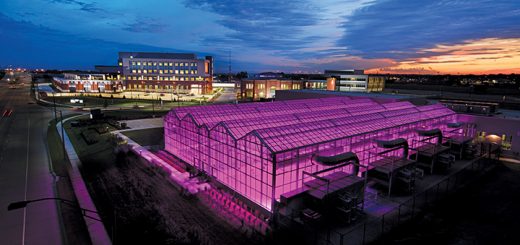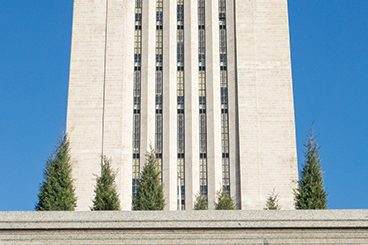Union Plaza – Design Concept
Union Plaza stretches over three blocks and offers amenities for community interaction and events. The design concept expresses the nature and essence of water – and not just bodies of water such as lakes and rivers, but the different forms of water such as droplets, condensation and snowflakes. The designers used the patterns water creates such as ripples, splashes and waves and also what water leaves behind – staining and sediment. This concept was expressed in the park’s details. The forms of bollards and planters evoke water droplets and splashes. Pavement patterns represent dry stream beds and ripples. The primary function of the park to contain the 100 year flood is also represented in the design with a horizontal line on the retaining walls showing the water height during a 100 year flood.
This line is also transcribed across the trails with the elevation of the 100 year flood noted as well. Along with the overall concept of water, each block has a more specific focus. The O Street to P Street block focuses on natural ecological systems that are seen through the themes for the murals installed on the retaining walls, as well as the pavement patterns, which represent the dry streambeds that would have been present before Lincoln was established. The natural systems are also represented through the three fountains that work in tandem. The Ken Good fountain represents a rain or snow storm with the water from the top basin flowing into the lower basin symbolizing the rain waters seeping into the ground and replenishing our ground water. The cascading water feature is a nod towards our region’s groundwater as the water seeps out through the series of four walls.
The Windstream fountain becomes more dynamic and celebratory in nature as the water is collected and forms a whirl pool with a jet that then pushes the water back into the air.
The P Street to Q Street block focuses on community. The Jayne Snyder Trails Center is located on the north side of the block and will provide amenities for trails users, space for public gatherings, restroom facilities and offices for the Community Health Endowment. The Dickinson Dinsmore Graf Amphitheater, with seating for approximately 200, is located near the center of the block. The murals on the walls focus on community including Native American tribes and Pioneers that settled in this area. The Dean and Pat Muhleisen Memorial Fountain represents water’s impact on the development of Lincoln and is a nod towards the City’s former well located near the Elliott Elementary School.
The fountain represents an artesian well bubbling up from the earth with water that appears to be flowing out of the cracked earth. The pavement pattern ripples out from the fountain representing the water’s impact on the community of Lincoln. The ripples continue all the way to the Children’s Discovery Garden and along the Q Street streetscape to Antelope Valley Parkway.
Groundwater Colossus, a ceramic brick sculpture created by James Tyler using architectural stoneware, is also located in this area. The concept of water, through sound and text, is incorporated into the sculpture which is truly a modern day Colossus rising from the earth.
The Q Street to R Street block focuses on the flora and fauna of Nebraska. An overlook is located on the south side in the shape of an inverted vortex. It offers views along the channel as well as to the city, truly capturing the fact that Lincoln is an urban forest. The Assurity Overlook is planted to show the juxtaposition of native and agricultural plant material and includes bioretention cells that collect and clean the storm water runoff.
The Children’s Discovery Garden is located just north of the overlook and offers children a place to experience nature through play. Just north of Q Street the channel is widened and a small ponding area is formed. A whimsical snapping turtle sculpture is located here as well as a frog sculpture. Frogs, fish and ducks have taken up residence in the pond itself. The plaza pavement also has different animal track imprinted across it to represent the different species that would be found along Nebraska’s water ways.
The park also features paved trails that serve as a hub for the city’s commuter/recreational trails system. The trails provide balance for various users, with more passive trails on the west side and commuter trails along the east. The park also will interface with mass transit and features traffic calming measures along its edges.
Sustainable elements are used throughout Union Plaza.
Examples include water conserving nozzles and LED lights in the fountains; permeable pavers; unit pavement that can be removed and reconstructed in the future; drought tolerant native plants and turf; bioretention areas to help manage storm water and Silva Cells to support the large trees. The Jayne Snyder Trails Center features photovoltaic cells to generate power.
By Stacy Roach




Recent Comments